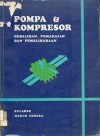 Ekonomi Energi Teori dan Aplikasi
Ekonomi Energi Teori dan Aplikasi

Ekonomi Energi Teori dan Aplikasi
Yayasan Purnomo Yusgiantoro. 2018. Kebayoran Baru
Indonesia
Text
15 x 23 cm ; xxv + 679 hlm
After nine-year hiatus, Prof. Purnomo Yusgiantoro, Ph.D finally once more published his new masterpiece as an Indonesia’s energy economy expert. This time, he brought a young energy economy expert whom also his first son, Dr. Luky Yusgiantoro to collaborate together in creating a new book, titled “Ekonomi Energi: Teori Dan Aplikasi”. This book consists of ten chapters, with each chapter bring different fundamental theories, the most updated data and fascinating issues in energy economics that could be a reliable reference for academics, practitioners as well as stakeholders.
The first chapter presents the introduction of the energy economics, which then leads to the description of why most of the energy market is imperfect market. There are also some global issues related to the energy such as energy resources region seizure, UNCLOS, and energy price fluctuations. The second chapter presents the application of micro-economy for the energy sector, such as the supply and demand model, cobweb theory, and non-equilibrium market. In addition to the previous chapter, the third chapter brings macroeconomic in the energy sector, such as the relationship between energy sector with the Gross Domestic Product (GDP), Gross National Product (GNP), various types of inflations, Gini index and exchange rates. The fourth chapter consists of various theories of production as well as energy costs such as production function, Constant Elasticity of Substitution (CES) using Cobb-Douglas function, energy depletion theories both for the non-renewable (Hotelling Theory) and renewable energy using (Maximum Sustainable Yield). The fifth chapter brings new studies about the economic criteria to measure the risk and uncertainty of energy investment such as Net Present Value (NPV), Rate of Return (RoR) and Payback Period (PB). The sixth chapter consists theories of investment financing in the energy sector, such as Weighted Average Cost Of Capital (WACC) and the scheme explanation of Public–Private Partnership. In the seventh chapter, there are explanations on how economy energy approaches the environmental impact that caused by the energy industry as well as energy conservation in each sector. Next, the eighth chapter delivers the industry into the energy economy perspective. The chapter also includes the difference between State-Owned (BUMN) and Private Owned Enterprises (BUMS) especially in their decision-making system as well as the explanation of Product Life Cycle and Technology Life Cycle inside the energy sector. The ninth chapter shows how the stakeholders determined the optimum energy pricing for both upstream and downstream industry. It also contains the explanation about the various types of price subsidy to the definition of the petroleum fund. The last chapter, tenth chapter, consists of the overview of the most updated conditions in global energy markets such as global oil supply, oil price information system, global oil crisis, as well as oil and gas investment.
9786025224409
Perpustakaan PEM Akamigas DIGITAL LIBRARY PEM AKAMIGAS (Call Number: 620.9 Yus e.)
